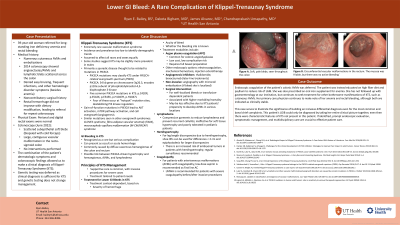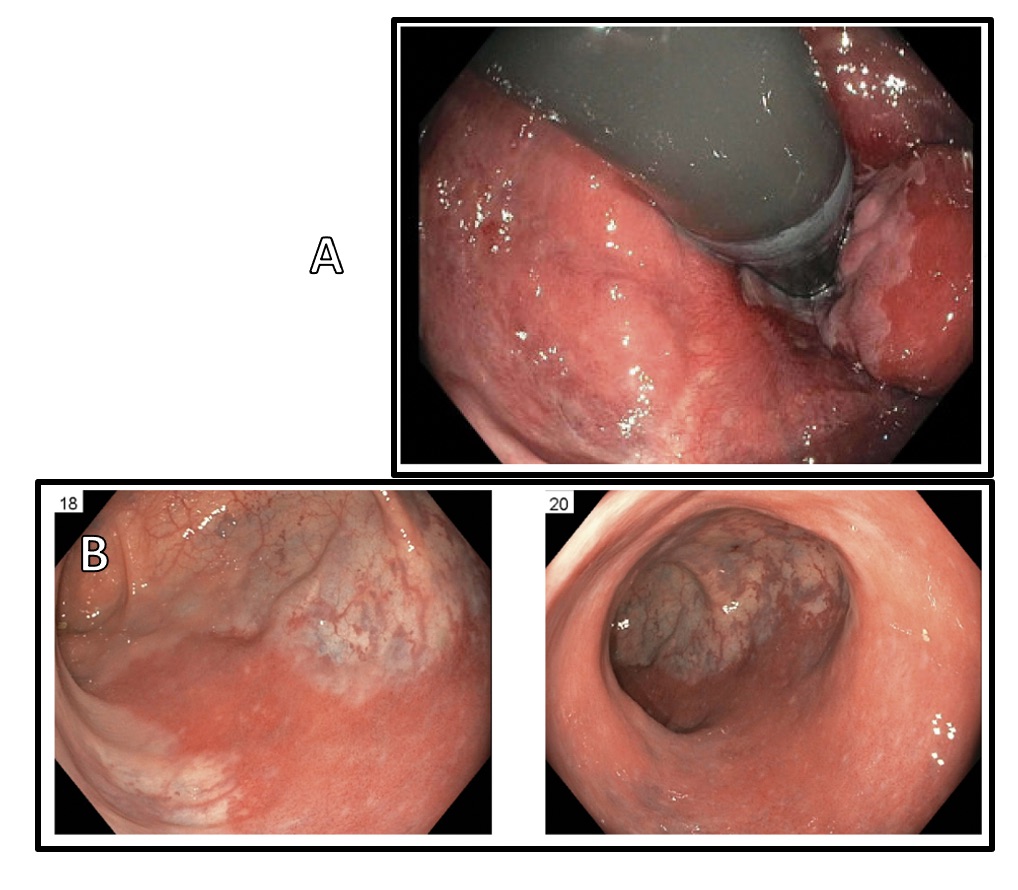Tuesday Poster Session
Category: GI Bleeding
P4219 - Lower GI Bleed: A Rare Complication of Klippel-Trenaunay Syndrome
Tuesday, October 29, 2024
10:30 AM - 4:00 PM ET
Location: Exhibit Hall E

Has Audio

Ryan E. Bailey, BS
Long School of Medicine
San Antonio, TX
Presenting Author(s)
Ryan E. Bailey, BS1, Dakota Bigham, MD2, James Alvarez, MD3, Chandraprakash Umapathy, MD2
1Long School of Medicine, San Antonio, TX; 2University of Texas Health San Antonio, San Antonio, TX; 3UTHSCSA, San Antonio, TX
Introduction: Klippel-Trenaunay Syndrome (KTS) is a rare disorder characterized by soft-tissue hypertrophy and venous malformations. While rarely fatal, KTS can present with several complications, namely lymphedema, bleeding, and tissue overgrowth.
Case Description/Methods: A 39-year-old woman was referred to our institution with a history significant for long-standing iron deficiency anemia and rectal bleeding. Her medical history included numerous cutaneous AVMs and embolizations. A colonoscopy from 2014 showed angioectasias/AVMs and lymphatic blebs scattered across the colon. The patient denied easy bruising, frequent infections, and other symptoms that would suggest other hematologic disorders besides anemia. The patient's surgical history was noncontributory. Because rectal bleeding had not improved with dietary modification, the patient's primary care provider referred her for a repeat diagnostic colonoscopy.
The colonoscopy was scheduled for late June 2022. Perianal and digital rectal examination were normal. Colonoscopic findings included scattered subepithelial soft blebs. These blebs were biopsied using cold forceps. Additionally, a localized area of the recto-sigmoid colon showed a large, contiguous vascular malformation. No other abnormalities were detected during the procedure. No interventions were performed.
The combination of the patient’s dermatologic symptoms and colonoscopic findings allowed us to make a clinical diagnosis of Klippel-Trenaunay Syndrome (KTS). Genetic testing was deferred as clinical diagnosis is sufficient for KTS and genetic testing does not change management.
Discussion: This case serves to illustrate the significance of building an inclusive differential diagnosis even for the most common and banal chief complaints. This patient’s LGIB could only be diagnosed by taking her entire clinical picture together, even then there were characteristic features of KTS not present in this patient. If identified, prompt endoscopic evaluation, symptomatic management, and multidisciplinary care are crucial to effective patient care.
This case serves to illustrate the significance of building an inclusive differential diagnosis even for the most common and banal chief complaints. This patient’s LGIB could only be diagnosed by taking her entire clinical picture together, even then there were characteristic features of KTS not present in this patient. If identified, prompt endoscopic evaluation, symptomatic management, and multidisciplinary care are crucial to effective patient care.

Disclosures:
Ryan E. Bailey, BS1, Dakota Bigham, MD2, James Alvarez, MD3, Chandraprakash Umapathy, MD2. P4219 - Lower GI Bleed: A Rare Complication of Klippel-Trenaunay Syndrome, ACG 2024 Annual Scientific Meeting Abstracts. Philadelphia, PA: American College of Gastroenterology.
1Long School of Medicine, San Antonio, TX; 2University of Texas Health San Antonio, San Antonio, TX; 3UTHSCSA, San Antonio, TX
Introduction: Klippel-Trenaunay Syndrome (KTS) is a rare disorder characterized by soft-tissue hypertrophy and venous malformations. While rarely fatal, KTS can present with several complications, namely lymphedema, bleeding, and tissue overgrowth.
Case Description/Methods: A 39-year-old woman was referred to our institution with a history significant for long-standing iron deficiency anemia and rectal bleeding. Her medical history included numerous cutaneous AVMs and embolizations. A colonoscopy from 2014 showed angioectasias/AVMs and lymphatic blebs scattered across the colon. The patient denied easy bruising, frequent infections, and other symptoms that would suggest other hematologic disorders besides anemia. The patient's surgical history was noncontributory. Because rectal bleeding had not improved with dietary modification, the patient's primary care provider referred her for a repeat diagnostic colonoscopy.
The colonoscopy was scheduled for late June 2022. Perianal and digital rectal examination were normal. Colonoscopic findings included scattered subepithelial soft blebs. These blebs were biopsied using cold forceps. Additionally, a localized area of the recto-sigmoid colon showed a large, contiguous vascular malformation. No other abnormalities were detected during the procedure. No interventions were performed.
The combination of the patient’s dermatologic symptoms and colonoscopic findings allowed us to make a clinical diagnosis of Klippel-Trenaunay Syndrome (KTS). Genetic testing was deferred as clinical diagnosis is sufficient for KTS and genetic testing does not change management.
Discussion: This case serves to illustrate the significance of building an inclusive differential diagnosis even for the most common and banal chief complaints. This patient’s LGIB could only be diagnosed by taking her entire clinical picture together, even then there were characteristic features of KTS not present in this patient. If identified, prompt endoscopic evaluation, symptomatic management, and multidisciplinary care are crucial to effective patient care.
This case serves to illustrate the significance of building an inclusive differential diagnosis even for the most common and banal chief complaints. This patient’s LGIB could only be diagnosed by taking her entire clinical picture together, even then there were characteristic features of KTS not present in this patient. If identified, prompt endoscopic evaluation, symptomatic management, and multidisciplinary care are crucial to effective patient care.

Figure: A - Soft, pale blebs; seen throughout the colon
B - Circumferential vascular malformations in the rectum. The mucosa was friable, but there was no active bleeding
B - Circumferential vascular malformations in the rectum. The mucosa was friable, but there was no active bleeding
Disclosures:
Ryan Bailey indicated no relevant financial relationships.
Dakota Bigham indicated no relevant financial relationships.
James Alvarez indicated no relevant financial relationships.
Chandraprakash Umapathy indicated no relevant financial relationships.
Ryan E. Bailey, BS1, Dakota Bigham, MD2, James Alvarez, MD3, Chandraprakash Umapathy, MD2. P4219 - Lower GI Bleed: A Rare Complication of Klippel-Trenaunay Syndrome, ACG 2024 Annual Scientific Meeting Abstracts. Philadelphia, PA: American College of Gastroenterology.
